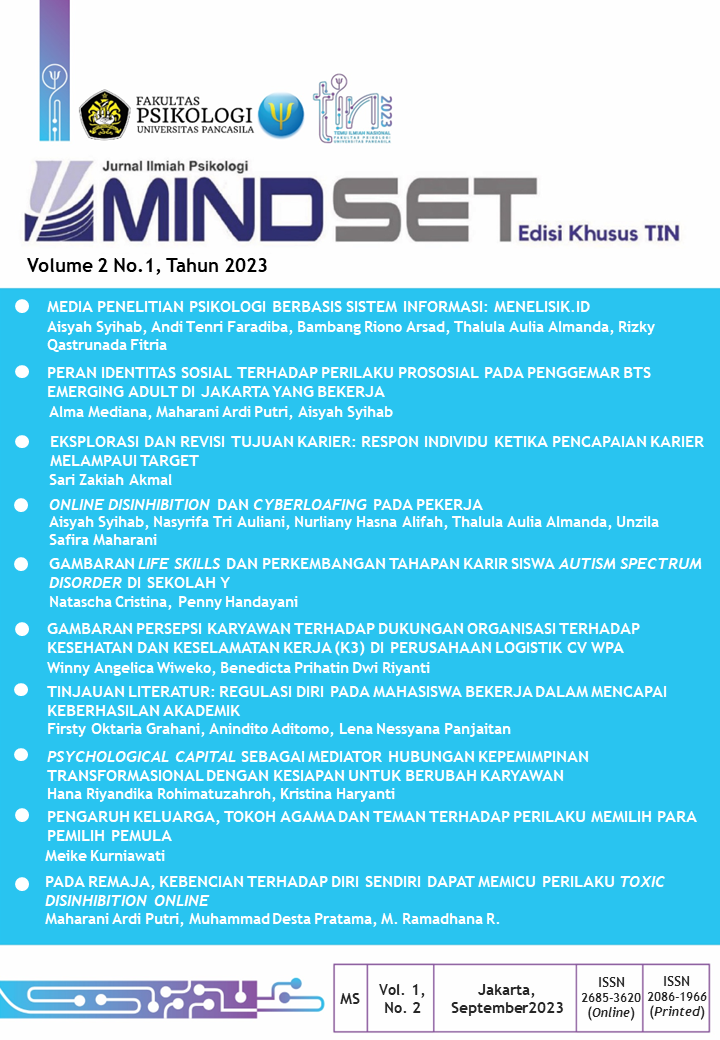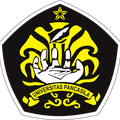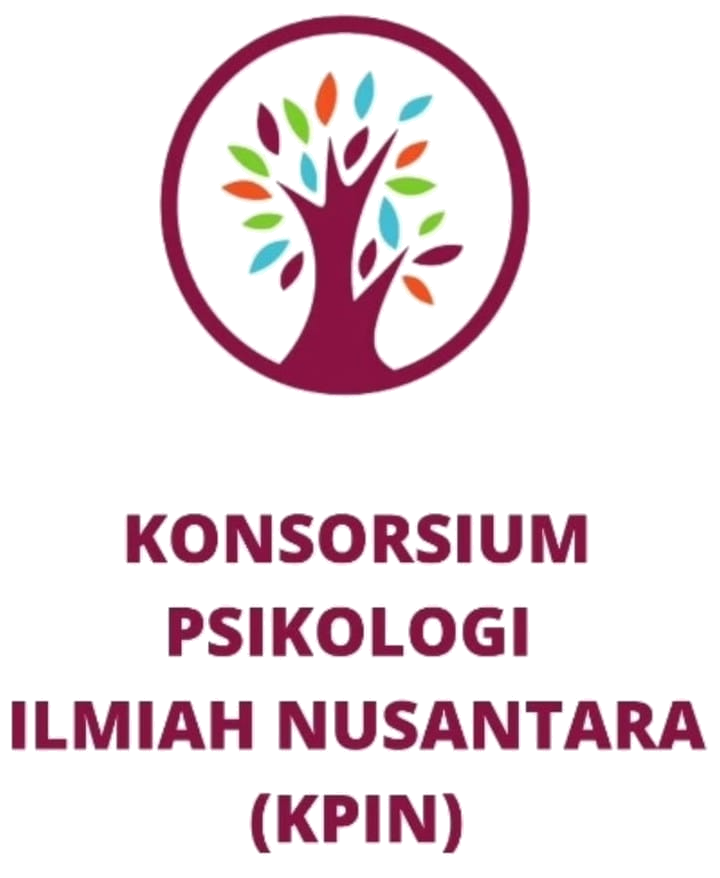Online Disinhibition dan Cyberloafing pada Pekerja
DOI:
https://doi.org/10.35814/mindset.v2i01.5515Keywords:
cyberloafing, employee, online disinhibitionAbstract
Cyberloafing or the behavior of employees who carry out online activities outside of work during working hours has become commonplace over the last 20 years, and is difficult to avoid it because almost all jobs require internet access. This activity can interfere with the effectiveness of their works, but there is not much research on this, especially when it is related to online disinhibition. Online disinhibition is a psychological condition experienced by individuals who feel more comfortable doing certain behaviors online than in real life. This study aims to determine the relationship between online disinhibition and cyberloafing among employees. This research was conducted using quantitative research methods, especially correlational analysis. The measurement tools were an adaptation of the Instrument of Social Purpose Cyberloafing (Megawati, et al., 2023) to measure cyberloafing behavior and the Online Disinhibition Scale (Suler, 2004) to measure online disinhibition. Respondents in this study totaled 121 people, obtained by convenience technique sampling, in which respondents filled out a research questionnaire on the site of menelisik.id. The results obtained in this study show that there is a relationship between online disinhibition and cyberloafing among employees. Suggestion for further research to do the research to find the role of online disinhibition in cyberloafing. Applicative suggestion for company leaders to create an atmosphere that makes employees more comfortable working so as to reduce cyberloafing behavior among them.
References
APJII (Asosiasi Penyelenggara Jasa Internet Indonesia). (Maret 10, 2023). Survei APJII pengguna internet di Indonesia tembus 215 juta orang. APJII.or.id. Diakses dari: https://apjii.or.id/berita/d/survei-apjii-pengguna-internet-di-indonesia-tembus-215-juta-orang
Ardilasari, N. & Firmanto, A. (2017). Hubungan self-control dan perilaku cyberloafing pada Pegawai Negeri Sipil. Jurnal Ilmiah Psikologi Terapan. 5(1), 19-39.
Cahyarudin, F.D. 92023). Hubungan antara online disinhibition dengan cyberbullying pada pengguna Facebook. Skripsi. Fakultas Psikologi. Universitas Muhammadiyah Malang.
de Lara, P.Z.B., Viera-Armas, M., & Garcia, G. D. B. (2020). Does supervisor’s mindfulness keep employees from engaging in cyberloafing out of compassion at work? Personnel Review, 49(2), 670-687. DOI 10.1108/PR-12-2017-0384
Griffiths, M. (2010). Internet abuse and internet addiction in the workplace. The Journal of Workplace Learning, 22(7), 463-472. DOI 10.1108/13665621011071127
Herdiati, M.F., Sujoso, A.D.P., & Hartanti, R.I. (2015) pengaruh stresor kerja dan persepsi sanksi organisasi terhadap perilaku cyberloafing di Universitas Jember. e-Jurnal Pustaka Kesehatan, 3(1), 179-185.
Joinson, A. N. (1998). Causes and implications of disinhibited behavior on the Internet. In J. Gackenbach (Ed.), Psychology and the Internet: Intrapersonal, interpersonal, and transpersonal implications (pp. 43–60). Academic Press.
KBBI. (2016). Arti kata daring. Diakses darihttps://kbbi.kemdikbud.go.id/entri/daring
Kusnandar, V.B. (November 15, 2022). Ini jumlah angkatan kerja Indonesia pada Agustus 2022. Databoks.Katadata.co.id. Diakses dari: https://databoks.katadata.co.id/datapublish/2022/11/15/ini-jumlah-angkatan-kerja-indonesia-pada-agustus-2022
Lim, V. K. 2002. The IT way of loafing on the job: Cyberloafing, neutralizing and organizational justice. Journal of Organizational Behavior: The International Journal of Industrial, Occupational and Organizational Psychology and Behavior, 23(5), 675-694. https://onlinelibrary.wiley.com/doi/abs/10.1002/job.161.
LMS Spada. (2021). Definisi cybercrime. Diakses dari: https://lmsspada.kemdikbud.go.id/mod/page/view.php?id=57347#:~:text=Dunia%20Cyber%20atau%20dalam%20istilah,secara%20online%20(terhubung%20langsung).
Mahendra, M.A & Tefa, G. (2022). Studi fenomenologi perilaku cyberloafing PNS di Badan Kepegawaian dan Pengembangan Sumber Daya Manusia Kabupaten karangasem Provinsi Bali. Jurnal MSDA (Manajemen Sumber Daya Aparatur), 1(1): 1-15. DOI 10.33701/jmsda.v10i1.2509
Maurhea, S.D. (2020). Pengaruh perilaku cybeloafing terhadap produktivitas kerja pada karyawan Bank Riau Kepri cabang Syariah Pekanbaru. Skripsi. Program Studi Psikologi. Fakultas Psikologi. Universitas Islam Riau. Pekanbaru.
Mazidi, A.K., Rahimnia, F., Mortazavi, S. & Lagzian, M. (2021). Cyberloafing in public sector of developing countries: job embeddedness as a context. Personnel Review, 50(7), 1705-1738. DOI 10.1108/PR-01-2020-0026
Megawati, H., Rustyawati, R., Suryaratri, R.D., & Kusumawardhani, S.J. (2023). Analisis faktor konfirmatori terhadap skala cyberloafing mahasiswa. Jurnal penelitian dan Pengukuran Psikologi, 12(1), 35-43. DOI: https://doi.org/10.21009/JPPP.121.05
Oxford Learners Dictionaries. (2023). Definition of loafing. Diakses dari: https://www.oxfordlearnersdictionaries.com/definition/english/loaf_2?q=loafing
Rahmah, I.L., Nurmayanti, S. dan Surati. (2020). The role of cyberloafing mediation on the influence of role conflict and role ambiguity on performance. International Journal of Innovative Science, Engineering & Technology, 7(7), 207–220.
Santoso, Y.O. & Wibowo, D.H (2022). Perilaku cyberloafing dapat menimbulkan prokrastinasi kerja yang membahayakan perusahaan. Psikoborneo: Jurnal Ilmiah Psikologi, 10(4), 702-710. DOI: http://dx.doi.org/10.30872/psikoborneo.v10i4.9133
Sarfraz, M., Khawaja, K.F., & e-Farwah, U. (2023). Is the internet a double-edged sword for organizations? An empirical study on cyberloafing. Information and Technology Management. https://doi.org/10.1007/s10799-022-00385-5
Suler, J. (2004). The online disinhibition effect. Cyberpsychology and Behavior, 7(3), 321–326.
Udris, R. (2014). Cyberbullying among high school students in Japan: Development and validation of Online Disinhibition Scale. Computer in Human Behavior, 41, 253-261. http://dx.doi.org/10.1016/j.chb.2014.09.036
Wachs, S. & Wright, M.F. (2018). Association between bystanders and perpetrators of online hate: The moderating role of toxic online disinhibition. International Journal of Environmental Research and Public Health, 15, 1-9. doi:10.3390/ijerph15092030
Wu, S., Lin, T.C., & Shih, J.F. (2016). Examining the antecedents of online disinhibition. Information Technology & People, 30(1), 189-209. DOI 10.1108/ITP-07-2015-0167












